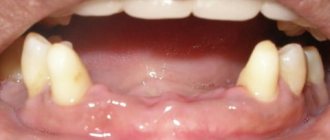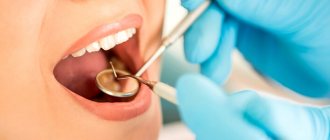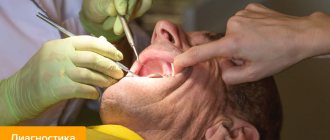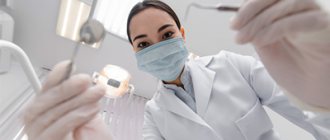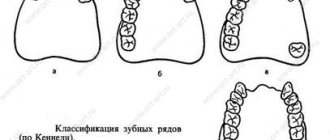The most common dental diseases that a child can develop are caries and pulpitis. However, there are more serious pathologies, and parents need to be aware of them.
One of these diseases is edentia, which is characterized by the absence of teeth. This disease affects both primary and permanent teeth and can develop at any age. There are four main types of edentia:
- depending on the number of missing teeth - complete or partial. The first type is uncommon, diagnosed in only 3-5% of people;
- in accordance with the causes of the disease - primary (congenital) or secondary (arising during life).
Edentia of twos can also occur - the absence of paired front teeth located in the central part of the jaw.
Reasons for the development of edentia
It is difficult to name the exact causes of this pathology, because to date the disease has not been sufficiently studied. According to existing hypotheses, the first manifestations of complete or partial adentia in a child occur during the period of intrauterine development. They are associated with disturbances in the development of the ectodermal layer and the formation of organ roots. Edentia of two can also be caused by endocrine pathologies of the fetus, as well as genetic reasons.
As for secondary adentia, experts identify several variants of the clinical picture of this disease, which is diagnosed relatively often. According to statistics, tooth loss is most often caused by the following factors:
- caries;
- other advanced oral diseases, in particular periodontitis and periodontal disease. Lack of treatment leads to destruction of the masticatory organ;
- other pathologies that cause a general deterioration in the body’s condition. As a rule, they are associated with the functioning of the endocrine and immune systems;
- age-related changes that lead to deterioration in health, including tooth loss;
- hereditary factors
- mechanical injury, for example, a strong blow. In this case, the tooth may fall out either immediately if the main impact was on it, or later if the gums were damaged or the tooth remained in the jaw but was severely damaged. Mechanical trauma is one of the most common causes of adentia, including in children. In a small child, it can lead to developmental defects in baby and permanent teeth.
Symptoms of adentia in children and adults
Diagnosis of this disease takes a long time. But there are a number of symptoms indicating its presence. It is especially important to take them into account when determining dental edentia in children. These factors include:
- reduction of jaws (both or just one);
- signs of retraction of the cheeks and lips;
- deformation of the alveolar processes;
- the appearance of wrinkles and folds approximately in the places where the twos are located;
- manifestations of muscular atrophy of the oral cavity;
- change in jaw angles.
All these symptoms can lead to the formation of a malocclusion. Malocclusions, in turn, cause certain shifts of the teeth and the formation of gaps in the jaw. In some cases, growths may form that affect the appearance and make chewing difficult.
Complete secondary adentia can be caused by caries, periodontitis, or surgical intervention. The doctor may also notice scars from injuries that led to tooth loss. Another symptom that explains the loss of masticatory organs is the presence of cancer.
It is worth noting that there is a steady downward trend in the age of edentulous dental patients. Poor ecology leads to the fact that young people are increasingly faced with this problem.
Diagnosis and detection of the disease
Edentia is a serious problem, and to solve it it is very important to promptly and accurately identify the presence of pathology and its type.
The first stage of diagnosis is to conduct a visual examination. Based on the results obtained, the doctor determines whether adentia is primary or secondary.
Then it is necessary to take an X-ray of the jaw, especially if the initial examination showed that the disease is congenital. This can only be confirmed with an x-ray, in which a specialist will check for the presence of dental follicles or identify signs of abnormal development.
When identifying the causes of adentia in children, at the initial stage of diagnosis it is necessary to find out the structure of the root system and find out how things are under the gums. Therefore, in the treatment of childhood adentia, the method of panoramic radiography is used. It allows the doctor to obtain a detailed picture, including information about the structure of the bone tissue of the alveolar processes.
Why is timely diagnosis so important?
Timely detection of adentia is of such high importance for one serious reason. The fact is that before starting any therapeutic actions, it is necessary to diagnose and eliminate all existing pathologies.
First of all, these include inflammatory infections of the oral cavity. During treatment, it is recommended to preserve the roots of the teeth as much as possible, since the absence of roots can lead to the loss of the entire masticatory organ. In addition, it is necessary to carry out complete disinfection of the oral cavity.
If the doctor suspects the development of acquired adentia, it is necessary to find out the cause of the disease as soon as possible. This is due to the fact that some pathologies can lead to complications during prosthetics. To eliminate these risks, the dentist checks for the following symptoms during the examination:
- exostoses (benign growths on bones consisting of bone or cartilage tissue);
- unremoved roots covered with mucous membrane;
- tumors and inflammatory processes;
- infections of the oral mucosa.
Types of adentia and their diagnosis
General symptoms indicating the presence of the disease were discussed above. But there are also a number of signs characteristic of different types of adentia. Their knowledge can also help to identify pathology in a timely manner.
Primary complete edentia
The rarest type of disease and at the same time the most serious. With primary complete adentia, the patient does not even have the rudiments of teeth and their roots. This pathology leads to serious consequences, namely:
- facial symmetry is disrupted;
- the correct formation of the alveolar processes of the upper and lower jaws is difficult;
- the secretion of mucus and saliva in the mouth slows down, which can cause additional inconvenience to the patient.
One of the symptoms of primary complete adentia may be paleness of the mucous membranes. The absence of baby teeth in children can also be easily determined by palpation. If such signs are present, it is necessary to urgently take appropriate measures.
Primary partial edentia
It is expressed in the congenital absence of some teeth in the patient. If partial adentia is detected in a child, the x-ray will show gaps in the root system. It should be noted that the absence of wisdom teeth is not considered edentulous.
As the disease develops, diastemas and tremata are formed - spaces between the chewing organs. In simple terms, the teeth begin to “creep”: if you look at a photo of edentia in children, you will notice large gaps between the teeth.
Primary partial adentia can be symmetrical or asymmetrical. In the first case, there are no paired teeth - doubles or fangs. Asymmetrical adentia means the absence of teeth in different places of the jaw.
Secondary complete edentia
This type of disease is diagnosed when it is acquired. Its symptoms can be observed on all jaws or only on one. Both primary and permanent teeth may be missing. Secondary complete adentia is diagnosed when all the chewing organs have fallen out or needed to be removed due to another disease.
One of the main unpleasant consequences of this pathology is jaw deformation. It becomes closer to the nose, soft tissues begin to retract. Also, this type of disease is characterized by muscle atrophy, leading to disruption of the shape of the entire jaw or one or both alveolar processes.
In addition, the loss of all teeth immediately leads to everyday problems - the patient will not be able to chew independently, and will also begin to swallow some sounds.
Secondary partial edentia
This is the most common type of disease, in which several masticatory organs are missing from the dentition. The loss of canines, twos or other teeth often leads to increased sensitivity of bone tissue. This is due to the gradual wear of the side walls of adjacent teeth.
With this complication, the patient faces discomfort, due to which he gradually stops eating solid food, which is difficult to chew. Both children and adults face this problem.
Possible consequences of edentia
Tooth loss is a serious disease that can lead to various unpleasant consequences, including the development of other serious diseases. Among them are the following:
- impaired jaw development, which leads to difficulty pronouncing various sounds;
- the patient is forced to exclude solid foods from his diet, which causes problems with intestinal motility and disruption of the gastrointestinal tract;
- development of persistent psychological discomfort. The patient’s self-assessment is distorted and depression may develop;
- in the complete absence of teeth, the jaw develops abnormally and can put pressure on any area of the head, thereby provoking the appearance of temporal tumors.
Absence of milk teeth – edentia. Second row of teeth. Do adults have baby teeth?
Very, very rarely, but such an anomaly of the dental system occurs as adentia, that is, the absence of milk teeth and even their rudiments. Adentia is determined no earlier than 12-15 months, using an X-ray examination using an X-ray machine, and only after examination by a qualified dentist.
Our clinic has a more modern device that allows us to adequately and efficiently examine the condition of the dental system from any angle, completely safe for children - a radiovisiograph.
Adentia can be primary - when the rudiments of baby teeth are completely absent, and there is a lack of teeth in the oral cavity due to their retention in the jaw - retention. All teeth may be missing (completely edentulous) or only some (partially edentulous). Absence of teeth is more often observed with permanent teeth - in adults, and much less often - with milk teeth.
The causes of edentia in children are most often health problems in the mother during pregnancy (genetic diseases, viral infections, poisoning, stress, etc.), smoking, treatment with strong drugs, which prevents the formation of tooth buds or their death at later stages. With edentia, the jaws also develop poorly, the face becomes asymmetrical, and the bite is distorted. During the period of primary occlusion, partial adentia is more common - the absence of individual teeth and the formation of large gaps between three existing teeth. Treatment at an early age is aimed at medicinal stimulation of teething and jaw development. At an older age, it is possible to make removable dentures that fill the dentition. Fixed dentures for children are unacceptable, and for those under 21 years old they are not recommended.
The child is growing a second row of teeth
The situation is completely opposite - the child is growing a second row of teeth. This pathology is rare in primary dentition and is quite common during the growth of permanent teeth. If a child has supernumerary teeth, they interfere with the development and growth of permanent teeth, move them to the side, or turn them around an axis, and therefore must be removed.
We are often asked whether all children’s teeth change, and whether adults still have baby teeth. In the natural course of events, all milk teeth should fall out, and in their place permanent teeth should grow, plus 12 molars for a complete adult set - 32 teeth. But sometimes there is a malfunction - and a baby tooth, and sometimes even a few, don’t fall out. The fact is that under the milk tooth the germ of a permanent tooth does not form or dies, which means that the root of the milk tooth does not dissolve and it does not fall out at the appointed time. The second reason may be that the germ is very deep or underdeveloped, and therefore it cannot push out the baby tooth. Milk teeth that have not been replaced by permanent ones are called residual or persistent. What to do about it? You should contact your dentist about this problem. If the loss of baby teeth in children was not complete, and by the age of 16-17 the child still has baby teeth, contact a specialist at the Utkinzub clinic. Only after a thorough examination will the doctor decide whether to leave the tooth if there is no permanent tooth germ underneath it, or remove it if there is a germ germ, with parallel stimulation of the growth of the permanent tooth.
It is more important to know the causes of this pathology. This may be heredity, injury or inflammatory diseases of the jaw bones, disruption of the hormonal system, in particular the thyroid gland. And one of the most common causes is inflammation in baby teeth that is not cured in time - pulpitis and periodontitis. The disease spreads to the germ of the permanent tooth and destroys it in the jaw. It is for this reason that we constantly draw the attention of parents to the need for careful care of baby teeth (“Care for baby teeth”) and timely treatment of caries and other diseases.
